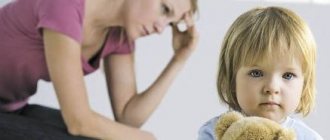Mental disorders in childhood are now not such a rare occurrence. Despite the development of medicine in general and psychiatry in particular, the number of patients with developmental features of the autism spectrum, schizophrenia and other diseases is constantly increasing.
Atypical autism is less common in children, but these statistics continue to grow. It was first identified as a separate disease in ICD-10. Previously, the concept of “autism” was used as a sign of schizophrenic disorders, psychoses, and mental retardation. This medical term has already thoroughly entered our lexicon, but not everyone knows how serious this disease is. However, the fact that a child suffering from it is considered disabled indicates the seriousness of the diagnosis.
Autism concept
Simply put, this is loneliness. The patient loses the ability to communicate with people and interact with the world around him in general. He withdraws into himself, into his own dimension, where there is no place for anyone else. From the outside it looks like a reluctance to communicate with anyone, but in fact, autistic people simply do not know how to do this.
From a physiological point of view, this is a violation of the perception of signals coming through auditory, visual, tactile and other receptors. They either do not completely reach the necessary think tanks, or do so incompletely. Accordingly, the reaction to current events changes.
Autism, or more accurately, autism spectrum disorder, is a complex developmental disorder that usually manifests itself at an early age. It is caused by pathology of the functioning of the nervous system.
Symptoms
Atypical autism is more difficult to identify than its classic form, so the diagnosis is often delayed. Missed onset of the disease and late treatment has a negative impact on further results.
The most surprising and at the same time confusing factor is the huge variety and individuality of symptoms.
Common features of the disease are disturbances in social inclusion, communication and interaction with others.
At home, it is quite difficult to recognize atypical autism in children. Most often, relatives attribute certain oddities and unusual behavior to age-related changes or temperamental characteristics. They are in no hurry to contact a specialist with such problems, thereby missing the initial stage of the disease.
The distinctive factors of atypical childhood autism are:
- Age limits. This type of disorder has the peculiarity of developing not in early childhood, but at a later date - 3 years, 6–10 years, or adolescence. These are those periods of a child’s life when he experiences stress about adapting to a new team, the need to communicate with strangers, and building relationships.
- Socialization. Despite the fact that the patient is completely dependent on his parents, he reacts poorly to them. The baby may not worry about the absence of his mother or, on the contrary, show concern, and behave coldly and unkindly in front of her.
- Speech. It is either absent or reduced to the use of individual words, or, in extreme cases, phrases. Constructing sentences is too difficult a task.
- Emotional breakdown. During normal activity, absolute or selective non-contact may be observed. Intense external stimuli - bright lights, loud sounds - cause fear. Uncharacteristic, unpredictable reactions to events may occur.
- Behavior. There is a negative reaction to touch. Such children do not strive to copy adults or peers and prefer loneliness.
With normal physical development, mental retardation is most often observed.
Assessing the level of intellectual abilities can be difficult, since a diagnosis made at an early age can be corrected.
Diagnosis worsens due to disorders of the speech apparatus and communication skills. During tests, the child, as a rule, knows the solution to the problem, but does not say it.
Atypical autism
One of the key manifestations of pathology is a violation of the ability to establish social contacts. This symptom can be severe or weak. In the stable period, patients do not refuse to communicate, but cannot start and maintain a conversation. In severe forms of autism, there is a pronounced desire to remain alone, to isolate oneself from the outside world. Patients do not want to interact with people through speech, gestures or glances. Attempts to force contact cause impulsive emotional and motor reactions - screaming, crying, self-harm, aggression. A specific speech disorder includes the inability to formulate and express one’s own thoughts; in severe cases, understanding spoken phrases and words is difficult. The ability to abstract is lost - patients do not understand the figurative meaning of expressions, sarcasm, humor.
Affective coldness is characterized by difficulties in expressing emotions, feelings and experiences. Patients seem indifferent and indifferent to what is happening, unable to be happy or sad. They cannot empathize, show love or hate. In children, emotional relationships with their mother often manifest themselves as pathological attachment, based on fear of unfamiliar situations, objects and people, rather than on love and the need for maternal care. Excessive irritability of patients is explained by increased sensitivity to external factors.
Rigidity of the psychomotor sphere is represented by stereotypies and lack of flexibility of thinking. Motor activity includes various types of repeated non-purposeful actions: patients knock objects on hard surfaces (toys on the floor, spoon on a table), sway while sitting or standing, walk in a circle or around the perimeter of the room. Due to a pronounced decrease in adaptive abilities, with any changes in the environment or daily routine, a feeling of fear and panic arises. Patients tend to live surrounded by familiar things and perform the same rituals every day. Another symptom is sensory disturbances. In autistic people, the perception and processing of sensory information coming from the visual, auditory, tactile, olfactory and taste analyzers occurs differently. This disrupts the process of cognition of reality, and sometimes manifests itself in unusual abilities, for example, eidetic memory, synesthesia.
In patients with childhood malignant schizophrenia, regressive-catatonic attacks occur, the depth of the autistic component progresses to a severe degree. In patients with Rett syndrome, autism increases gradually, from mild to severe, then a regression stage begins, resulting in the formation of negativism, motor agitation and impulsivity, stereotypical movements and actions. For fragile X syndrome, attacks of catatonia with regression at 12-14 months of life are typical. During the period of psychosis, the depth of autism is severe, while in remission it is mild to moderate. At the end of the psychotic state, catatonia and stuporous states, echolalia, and selective mutism are observed. With trisomy 21, the disorder manifests itself at 24-36 months and has the character of a regressive-catatonic psychosis with a sequential change of all three stages. Psychosis ends 4-7 months after the onset, the severity of autism is weakened.
Features of the course of the disease
Children with autism have a very difficult time mastering everyday skills that everyone takes for granted. Eating normally is difficult. They are extremely selective and picky when it comes to food. For example, a child eats only semolina porridge, and no variety of dishes will convince him to try something else. If there is no porridge, he will starve. In the end, his mother will cook it and feed him.
The toilet is another problem. Children do not see the point of going to the potty, and cannot understand why adults persistently strive for this. This happens because from early childhood they have a very weak (or no) reaction to such stimuli as:
- cold;
- wet diapers
- hunger;
- unpleasant odors;
- touch.
In play activities, toys are most often completely ignored. Instead, the child prefers to use household items. There is usually no plot of the game; only stereotypical movements are observed, such as spinning in the hands or moving from place to place. An autistic person may sniff, touch, lick a new object for a long time, move it in front of his eyes, or crawl on his knees around it.
Due to speech impairment, it is almost impossible to conduct a dialogue with the patient; he simply will not support it. However, the baby can remember fairly long phrases from films and television shows and reproduce them accurately. When you contact him with a question, he may repeat it or not respond at all.
Reasons for development
The main factor in the development of early autism is considered to be a deficiency of the central nervous system. The reasons why it occurs are as follows:
- genetic predisposition;
- chromosomal abnormalities;
- organic lesions of the central nervous system in pathologies of pregnancy and childbirth;
- premature schizophrenic process;
- some congenital diseases.
Modern medicine already knows about thirty similar nuances. Therefore, pathologies such as mental retardation and autism spectrum disorders are becoming more common.
The likelihood of having a child with special psychological needs exists in every family.
The actions of various factors or their combination introduce individual characteristics into each patient. The character and type of personality also leaves an imprint on the course of the disease. Even with similar symptoms in the same situations, different children may behave differently.
Medical history
The term “autism” has been used for over 100 years (since 1908). It was first coined by Eugen Bleuler, a Swiss psychiatrist, and was used to describe patients with schizophrenia who were particularly self-absorbed. The term autism, which Bleuler used, comes from the Greek word autós, which means “oneself.” It was intended to describe the “isolated self” that he saw in people with schizophrenia [8]. In fact, these diagnoses are different because a child with autism does not have hallucinations, illusions, they do not use speech to convey their irrational thoughts, because they often do not use speech at all. In addition, children with ASD have stable symptoms throughout their lives, and a diagnosis of schizophrenia usually involves periods of remission.
In 1943, a doctor named Leo Kanner conducted observations of groups of children who had previously been considered mentally retarded. He noted that the children had difficulties in social interaction, anxiety when deviating from their usual way of life, echolalia, a limited repertoire of spontaneous activity, but at the same time good intellectual potential, good memory, and hypersensitivity to sensory influences. Kanner coined the term “early childhood autism” (ECA) to describe a set of symptoms in the children he studied [8].
German scientist Hans Asperger described a “milder” form of autism in 1944, which until today was known as Asperger syndrome. He described cases of boys who were very intelligent but had problems with social interactions. He noted that the children had difficulties with eye contact, stereotyped words and movements, and resistance to change, but they did not have speech and language deficits. Unlike Kanner, Asperger also noted problems with coordination in these children, but at the same time more abilities for abstract thinking. Unfortunately, Asperger's research was not discovered until three decades later, when people began to question the diagnostic criteria used at the time. It was not until the 1980s that Asperger's work was translated into English, published and became known [8], [9].
In 1967, psychiatrist Bruno Bettelheim wrote that autism does not have an organic basis, but is the result of being raised by mothers who consciously or unconsciously did not want their children, which in turn led to reticence in their relationships with them. He argued that the main cause of the disease was negative parental attitudes towards infants during the critical early stages of their psychological development [10].
Bernard Rimland, a psychologist and father of a child with autism, disagreed with Bettelheim. He couldn't accept the idea that his son's autism was either his parenting or his wife's. In 1964, Bernard Rimland published Infantile Autism: A Syndrome and Its Implications for the Neural Theory of Behavior, which pointed the direction for further research at that time [8].
Autism became better known in the 1970s, but at that time many parents still confused autism with mental retardation and psychosis. Scientists have begun to clarify the etiology of the disease: a 1977 study of twins showed that autism is largely due to genetics and biological differences in brain development [10]. In 1980, the diagnosis of infantile autism was first included in the Diagnostic and Statistical Manual of Mental Disorders (DSM); the disease is also officially separated from childhood schizophrenia. In 1987, the DSM replaced "infantile autism" with the broader definition of "autistic disorder" and included it in the third revision. At the same time, psychologist and Ph.D. Ivar Lovaas published the first study showing how intensive behavioral therapy could help children with autism, giving parents new hope (Figure 3) [8], [9]. In 1994, Asperger's syndrome was added to the DSM, expanding autism spectrum diagnoses to include milder cases [10].
Figure 3. Scientists who have contributed to the study of autism spectrum disorders
sciencenews.org, findagrave.com, psycho.by, orthomolecular.org and uvmeste.ru
In 1998, a study was published showing that the measles, mumps, and rubella (MMR) vaccine causes autism. The results of this study were disproved, but it attracted enough attention to cause confusion to this day (Figure 4) [9]. Today, there is no scientific evidence confirming the connection between vaccination and ASD [11]. Sadly, as recently as August 2021, a report came out saying that more than 50% of people in some European countries still believe that vaccines cause autism [12].
Figure 4. Fragment of a picture about the connection between ASD and vaccines
[13], figure adapted
Finally, in 2013, the DSM-5 combined all subcategories of the condition into one diagnosis of autism spectrum disorder, and Asperger syndrome is no longer considered a separate condition [8–10].
Childhood catatonic autism
A severe form of the disorder is expressed by catatonic agitation. It manifests itself most often by the following actions:
- monotonous walking, turning into running;
- scream;
- laughter, crying;
- prolonged stereotypic movements;
- impulsiveness expressed in unexpected actions.
Motor excitation suppresses instinctive activity and is expressed by negativism, attacks of numbness or waxy flexibility. Attempts at physical influence provoke resistance, hypertonicity and a persistent desire to avoid touching.
The attack may be accompanied by the pronunciation of individual words, syllables, and sounds. At the same time, the timbre of the voice and volume are constantly changing: the child either whispers something unintelligible, then suddenly suddenly starts screaming. There is a stereotypical repetition of phrases, either clear or drawn out and blurred.
Pathogenesis
The pathophysiological basis of the disease is damage to the children's brain. The provoking mechanism may be one or another factor that affects the child’s body at a certain age. This age coincides with the most critical period of development of the central nervous system and other body systems.
Ontogenesis of the central nervous system represents a certain sequence of these crises, which influence changes in physiological and mental processes in the child’s body. A characteristic feature of these periods is a special sensitivity to the effects of all unwanted and unfavorable factors.
Severe forms of AA usually occur between 16 and 18 months of age. It is at this time that important structural changes and ontogenetic processes occur in the child’s brain. This time also coincides with the peak of natural neuronal death in the visual cortex.
Establishing diagnosis
The sooner a disorder is identified, the faster the correct approach to it will be found, and an algorithm of actions will be built that will lead to rapprochement and establishment of contact. First of all, this is the task of parents.
Children a priori cannot be the same, but even with a discount for personality traits or upbringing, they must fit into generally accepted norms of development.
By the end of the first year of life, a child without autistic disorders should master the following basic skills:
- know your name and respond to it;
- communicate with others;
- react emotionally to various situations.
Modern diagnostic methods allow parents, even before the birth of a child, to examine a panel of genes responsible for mental retardation and the development of autistic disorders. The genetic panel makes it possible to both accurately confirm the diagnosis and further detailed examination of the patient.
If parents have not done such tests, but begin to notice autistic manifestations, medical help is clearly needed. The first authority they should contact is a child psychologist. If a negative trend is confirmed, he gives a referral to a neurologist or psychiatrist.
General detailed diagnostics are carried out in the following ways:
- conversation, observation of the child;
- tests, questionnaires;
- game, construction;
- MRI, CT scan of the brain;
- study of the autonomic and cardiovascular systems.
Children with autism may not respond to sound stimuli for a long time. For this reason, parents begin to suspect hearing problems. At the initial stage of diagnosis, it is important to make sure that there are no problems with auditory perception of information or to confirm them.
Clinical picture
As a rule, the first signs of the disease appear in children at 1–1.5 years of age, although with atypical autism symptoms appear later - after 3 years, after exposure to any provoking factors, for example:
- visiting kindergarten;
- departure of one or both parents for a long period of time;
- change of place of residence;
- an exciting trip for a child, etc.
Sometimes symptoms appear after severe infectious diseases, vaccination (while doctors emphasize to parents that the vaccination itself is in no way the cause of the disease - it would have appeared anyway, just a few months later), surgical interventions, injuries.
The main clinical manifestations of the disease are:
- lack of eye contact, reaction to one's own name, or interest in new toys or objects;
- change in “play skills”: play activity begins at 4–5 months, it gradually becomes more complex, “overgrown” with children’s fantasies, and a desire arises to involve other children or adults in it. With autism, a child either does not play at all, or his games are characterized by simplicity, lack of imagination, and stereotypies. He looks at the toy not directly, but from the side, avoiding outside interference;
- communication disorder: people with a similar diagnosis cannot correlate their needs with the interests of others, which leads to the incorrect formation of social stereotypes of behavior;
- inability to “switch” from one activity to another, and any attempt to distract the child provokes a completely unpredictable reaction;
- delayed speech development, lack of gestures accompanying speech, meaningless repetition of heard words;
- lack of emotional coloring of statements and actions;
- exacerbation of symptoms when the usual daily routine is disrupted.
Important! Such disorders can be clearly recognized in children over 2 years of age; up to this age, completely normal development is possible.
Features of the flow
There are several stages in the development of pathology.
- Stage of psychosis. Lasts from 1 month to six months, characterized by detachment, desire for solitude, “fading” of emotions, and decreased physical activity. During this period, psychological development stops. The duration of autistic psychosis can only be shortened with the help of specialized psychocorrection classes.
- Regression stage. Usually lasts about a year. Typically there is a further decrease in activity, the severity of all symptoms of the disease increases, and loss of speech and self-care skills is possible. Sometimes at this stage the child stops taking care of his own hygiene, and eating disorders (including eating inedible things) are possible. Motor stereotypies appear - children spontaneously raise their arms, stretch out their fingers, clench them into a fist or clasp their palms, press their elbows to their body, wave their arms, rub them together. Such stereotypical movements can persist throughout life.
- Catatonic stage (up to 2–3 years). The main symptoms of the disease are somewhat mitigated, but sometimes episodes of spontaneous, impulsive motor activity appear. The child suddenly stands up, runs around the room, climbs on furniture, jumps, etc.
After the end of the third stage, a noticeable improvement is noted. Although hyperactivity, impulsiveness, and obsessive movements remain, psychoemotional development is partially resumed. A reaction to others, speech appears, and everyday skills are gradually formed. During puberty, the disease usually worsens. But with appropriate treatment, serious consequences can be avoided.
Associated physical disorders
In addition to various mental disorders, atypical autism is characterized by the following symptoms:
- abdominal pain, irregular bowel movements, flatulence; adolescents are often diagnosed with enzymatic deficiency, gastritis, duodenitis;
- pathological changes in the hormonal profile;
- insomnia, which is associated with impaired production of melatonin, the “sleep hormone”;
- autoimmune reactions;
- epileptic seizures.
Behavior correction
A child's adaptation reserves also directly depend on the causes of autism. This should be facilitated by external factors:
- the right approach is organized;
- correctional work;
- treatment if necessary.
The best results in the fight against childhood atypical autism, the catatonic form of the disease and other autism spectrum disorders are achieved through teamwork. Positive dynamics can be achieved only with the coordinated actions of three components: all family members, medical workers, and teachers.
The patient needs to be taught social communication. Everyone who does not have such deviations sees this from early childhood in the example of parents and older children. An autistic person cannot do this; he needs a special approach and special corrective actions.
Treatment of atypical autism in the specialized clinic “Leto”
Therapy is carried out on an outpatient basis, hospitalization is needed only for strict indications (usually due to exacerbation of concomitant somatic diseases) and for a short period. This is due to the fact that a change in the usual environment can provoke a serious complication.
The main attention is paid to stimulation of speech and social development, behavior correction. Moreover, the doctor always works in close connection with parents and other family members. The psychotherapist works strictly individually with each patient and tells the relatives in detail about how to organize the child’s education and socialization.
Pharmacotherapy is not able to improve intellectual and cognitive development, however, concomitant disorders (aggression, insomnia, digestive disorders, seizures, etc.) are corrected with the help of medications. Sedatives, anticonvulsants, and enzymes are prescribed. Be sure to use multivitamin complexes and restoratives, drugs to normalize metabolism.
You can come for a consultation to our clinic or, in order not to injure the patient, call a doctor at home. You will receive more detailed advice from our operators. Call us 24/7 8(969)060-93-93.











